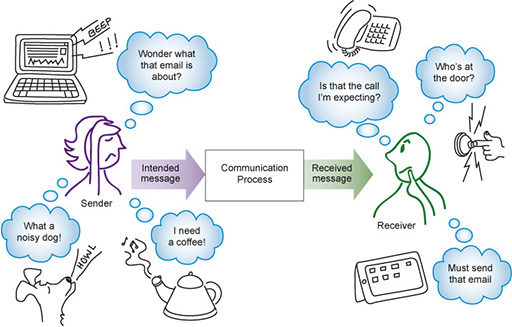How do people communicate?
The effective development of relationships requires you to communicate well, be organised and draw on skills that you might already have such as self-awareness, empathy with others, and so on. Whether you are working in a team, exercising leadership, managing your family or managing others’ work you will need to develop skills to work effectively with others.
Many of the skills involved relate to the process of communication. Talking and listening may be something you do every day, but most of us do not think about the process and therefore may not go through the loop necessary for learning to communicate more effectively. If you are a supervisor or manager, sometimes you may need assertiveness skills and working with others will additionally require you to be good at delegation as well as engaging with and developing your team.
The idea of information lies at the heart of communication. Information may be thought about in different ways. Some information may come as a surprise or as something more predicted, and some information may help to reduce uncertainty. It helps to think of information content in terms of its usefulness.
If you have a poor signal on your mobile then the noise of it breaking up might make it difficult to work out the words of the speaker. Figure 5 suggests that for everyday communication noise is not limited to the channel but is also subject to other distractions that limit concentration.
When talking to someone face-to-face your body language and tone of voice will probably be carrying far more information than the words you are speaking. Email is a particularly hazardous form of communication as the signal is limited to words and emoticons.
Whatever the means or channel of communications, you cannot know whether your recipient will be using the same assumptions to interpret your message as you were using when you ‘encoded’ it into words. Sensitivity to a recipient’s values, expectations, beliefs, prior knowledge and emotions can help you to put your message into words that are likely to convey the meaning you intended. Misunderstandings are particularly likely when the recipient thinks they know what you are likely to say, and hears what they expect, even if it is a long way from your intended message.
Having delivered your message, you can’t just assume it has been received in the way you intended. People don’t just passively receive messages: they actively select, filter and interpret them. If people do not think a message is likely to be interesting or important they may ignore it altogether, their minds may wander or they may switch their attention elsewhere.
Think about the implications of this for how you convey your organisation’s message or aims. For example, a person who believes passionately that there is an environmental crisis is likely to understand and respond to a campaigning leaflet from Friends of the Earth differently than someone who is highly sceptical.
Activity 7
Imagine you are a volunteer co-ordinator in a voluntary organisation and you’ve been asked to brief the other volunteers about some changes in how rotas will be organised. What might you do to prepare and communicate this message to this group?
Discussion
In order to communicate, we have to give expression to half-formed thoughts and ideas by putting them into acceptable words. It is often only in the process of expressing our ideas that we clarify our own thoughts.
This has implications if your message is at all complex, as in this example (since people are often fearful of or resistant to change). You will need to express, clarify and polish your ideas before communicating them. For written communication this usually involves a process of drafting and redrafting. Even for verbal communication you might want to make notes of the main points you want to communicate and – if it is important – practise saying them.
So thinking through which means of communication might be best for your message – such as email, a text, a phone call, a message on social media or a newsletter – is very important. The medium constrains and shapes the message that can be sent: for example, what you can say in a text is very different from what you can say face-to-face. How well a medium is used can also give authority to your message or undermine it. For example, a confident, well-delivered presentation may add weight to your message, whereas a poor presentation may undermine it.
The message in this example would probably be better communicated via a face-to-face meeting, as it is likely to generate discussion and possibly disagreement. It could otherwise be done by email or even individual phone calls.
4.3 Communicating with others

